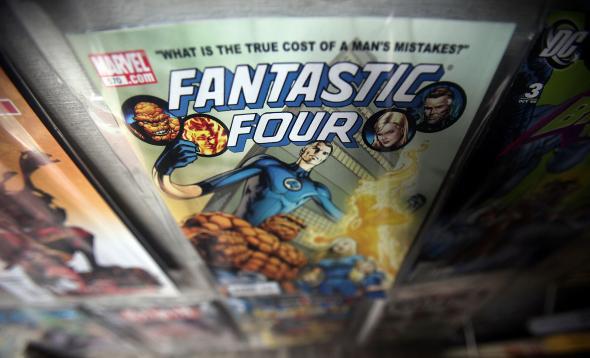This question originally appeared on Quora, the best answer to any question. Ask a question, get a great answer. Learn from experts and access insider knowledge. You can follow Quora on Twitter, Facebook, and Google Plus.
Answer by Robert Frost, have more than 15,000 comics in my collection:
In America, Wednesday is new comic book day. The two big publishers, Marvel and DC, each publish about 50 comics a month, which means about 12 comics each Wednesday. Individual titles are usually on a monthly schedule, although Marvel often likes to increase that schedule to biweekly for its most popular titles during the summer, and some artists work on a slower schedule, putting out one issue every two months.
If a comic begins in, say, March, the issue in March will be No. 1, the issue in April will be No. 2, the issue in May will be No. 3, and so on.
At the bottom of (usually) the first page of a monthly comic is the indicia. This is a body of text required by the postal service for periodicals that are sent through the mail.
The comic publishers have discovered that a comic book that says No. 1 on the cover will sell better than a comic that says No. 412. The “No. 1” implies a beginning—a convenient place to start reading, whereas No. 412 can be intimidating for some readers. But, on the other hand, there are books with a tremendous legacy. It is damn impressive that Detective Comics and Action Comics have more than 700 issues. This results in a sometimes confusing status with the issue numbers of comics. Publishers will often start the numbering over at No. 1 as a way of marketing a new creative team on the book or just to revitalize a book on the decline. But then they will often jump back to the high numbering when a key issue number is approaching (e.g. No. 500, No. 600, or No. 750).
When they do these renumberings, they sometimes (but not always) will increment the volume number. This is usually done if the book is changing significantly. However, volumes are also often used to denote collections of comics and also used when a book is canceled but then restarted at a later date. Fantastic Four Volume 1 ran for 416 issues, Volume 2 for 13 issues, Volume 3 for 72 issues, Volume 4 for 17 issues, and Volume 5 for 14 issues.
Comic publishers often like to “write for the trade.” That means that they like stories that are long enough to be collected into a softcover or hardcover bound book that can be sold in regular bookstores and to an audience that isn’t really interested in keeping up with a monthly periodical. They’ve found that a story that is between 100-120 pages is a good length for that market. Since a regular monthly comic is about 22 pages, that works out to be five or six issues.
When a publisher anticipates publishing multiple collections of a series, they will often label them Volume 1, 2, 3, and so on. A comic therefore may be published as a monthly periodical with the label Volume 1 inside the cover, but later be part of a collection labeled Volume 5, for example.
Here’s an example: Daredevil Volume 3 began in 2011. The new creative team was going to take the book in a new direction and the last several issues had not been well-received, so they decided to start a new volume. That volume has done rather well and has been republished in hardback collections about every six months. So, one might find himself in the confusing situation of reading the individual issue Daredevil Volume 3 No. 7 and then looking for the collection and finding issue No. 7 to be in the second collection, labeled Volume 2.
How exactly are Marvel Comics released? originally appeared on Quora. More questions on Quora:
